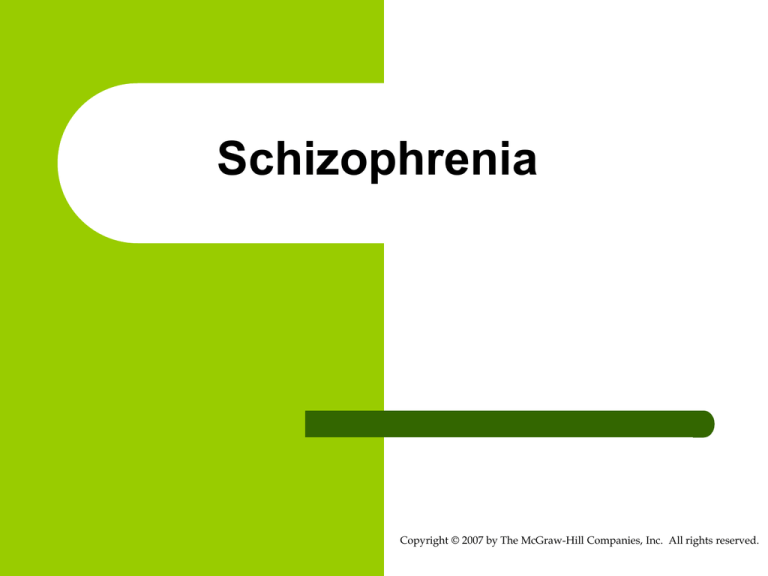
Schizophrenia
Copyright © 2007 by The McGraw-Hill Companies, Inc. All rights reserved.
A beautiful mind
• 1st half of movie
• Interview with John Nash and his family
Chapter 11
Copyright © 2007 by The McGraw-Hill Companies, Inc. All rights reserved.
DSM-IV Criteria for Schizophrenia
A.
B.
C.
Two or more core symptoms (next slide)
Significant impairment in work, academic performance,
interpersonal relationships, and/or self-care
Continuous signs of the disturbance for at least 6
months
Chapter 11
Copyright © 2007 by The McGraw-Hill Companies, Inc. All rights reserved.
Core Symptoms (Positive)
1.
Delusions -1.
2.
3.
4.
2.
3.
4.
Persecutory
Delusions of Reference
Grandiose Delusions
Delusions of Thought Insertion
Hallucinations
Disorganized Thought and Speech
Disorganized or Catatonic Behavior
Chapter 11
Copyright © 2007 by The McGraw-Hill Companies, Inc. All rights reserved.
Core symptoms (negative)
5.
Negative Symptoms
Affective Flattening (or Blunted Affect)
– Alogia: Severe reduction or complete absence of
speech
– Avolition: Inability to persist at common, goaloriented tasks
–
Video clips to demonstrate some of these symptoms
Chapter 11
Copyright © 2007 by The McGraw-Hill Companies, Inc. All rights reserved.
Biological Aspects of Schizophrenia
OVERVIEW
Neuroanatomy -- brain changes /
tissue loss
Genetics
Viral theories
Neurotransmitters
Chapter 11
Copyright © 2007 by The McGraw-Hill Companies, Inc. All rights reserved.
Biological Aspects of Schizophrenia
Secret Life
of the Brain
(episode 3)
Loss of
brain tissue
(NYTimes
video clip)
Chapter 11
Copyright © 2007 by The McGraw-Hill Companies, Inc. All rights reserved.
Biological Aspects of Schizophrenia
Structural Brain Abnormalities (tissue loss –
excessive pruning)
– Parietal cortex deficits (sensory experience)
– Frontal lobe deficits: Reduced volume and neuron
density in frontal cortex cause cognitive and
emotional deficits (perhaps especially negative
symptoms)
– Loss of myelin sheath?
Chapter 11
Copyright © 2007 by The McGraw-Hill Companies, Inc. All rights reserved.
Biological Aspects of Schizophrenia,
continued
Genetic Theories
–
–
–
Polygenetic influence
May be inheriting a general risk for psychosis
Epigenetics – environment + gene interaction
(e.g., Finnish study of children adopted away at
birth; Tienari et al., 2004): “Disordered” home
environment increases risk
Chapter 11
Copyright © 2007 by The McGraw-Hill Companies, Inc. All rights reserved.
Biological Aspects of Schizophrenia,
continued
Birth Complications & Prenatal Viral
Exposure
–
Podcast from “All in the mind” 11/2/07 on viruses
and immune system (4’’ – 14.30’’)
Neurotransmitter Theories
–
Imbalances in levels of or receptors for dopamine
cause symptoms; serotonin, GABA, and glutamate
may also play roles
Chapter 11
Copyright © 2007 by The McGraw-Hill Companies, Inc. All rights reserved.
Psychosocial Perspectives on
Schizophrenia
Social drift
Stress and relapse
Chapter 11
Copyright © 2007 by The McGraw-Hill Companies, Inc. All rights reserved.
Treatments for Schizophrenia
Biological Treatments: Antipsychotic
drugs (next slide)
Chapter 11
Copyright © 2007 by The McGraw-Hill Companies, Inc. All rights reserved.
Antipsychotics
Most are dopamine receptor antagonists
Older neuroleptics: Haldol & Thorazine
Newer (“atypical”): Clozaril, Seroquel,
Risperdal, Zyprexa
Somewhat of Trial and Error approach
Chapter 11
Copyright © 2007 by The McGraw-Hill Companies, Inc. All rights reserved.
Side Effects
Side Effects: Neuroleptics and Atypicals can cause
Sedation, weight gain
“Extrapyramidal” (Parkinsonian) side effects,
like tremor, akinesia (e.g., shuffling of feet)
Tardive Dyskinesia (long-term, irreversible -irregular/involuntary muscle movements)
Anticholinergic (dry mouth/eyes, blurred vision,
etc.)
Chapter 11
Orthostatic hypotension
Copyright © 2007 by The McGraw-Hill Companies, Inc. All rights reserved.
Treatments for Schizophrenia
Behavioral, Cognitive, and Social
Interventions: Recognition of
demoralizing attitudes they may have
toward their illness, operant conditioning,
modeling, family therapy, token
economies, self-help groups, assertive
community treatment programs.
Chapter 11
Copyright © 2007 by The McGraw-Hill Companies, Inc. All rights reserved.





